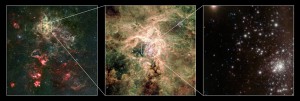- Von Leonard Burtscher
- Lesedauer ca. 2 Minuten
- Keine Kommentare
The young cluster RMC 136a
BLOG: Promotion mit Interferenzen

Using a combination of instruments on ESO’s Very Large Telescope, astronomers have discovered the most massive stars to date, some weighing at birth more than 300 times the mass of the Sun, or twice as much as the currently accepted limit of 150 solar masses. The most extreme of these stars was found in the cluster RMC 136a (or R136 as it is more usually named). Named R136a1, it is found to have a current mass of 265 times that of the Sun. Being a little over a million years old, R136a1 is already “middle-aged” and has undergone an intense weight-loss programme, shedding a fifth of its initial mass over that time, or more than fifty solar masses. It also has the highest luminosity, close to 10 million times greater than the Sun. R136 is a cluster of young, massive and hot stars located inside the Tarantula Nebula, in one of the neighbourhood galaxies of the Milky Way, the Large Magellanic Cloud, 165 000 light-years away. R136 contains so many stars that on a scale equivalent to the distance between the Sun and the nearest star there are tens of thousands of stars. Hundreds of these stars are so incredibly bright that if we were to sit on a (hypothetical) planet in the middle of the cluster the sky would never get dark. This montage shows a visible-light image of the Tarantula nebula as seen with the Wide Field Imager on the MPG/ESO 2.2-metre telescope (left) along with a zoomed-in visible-light image from the Very Large Telescope (middle). A new image of the R136 cluster, obtained with the near-infrared MAD adaptive optics instrument on the Very Large Telescope is shown in the right-hand panel, with the cluster itself at the lower right. The MAD image provides unique details on the stellar content of the cluster.
Veröffentlicht von Leonard Burtscher
www.ileo.deNach dem Studium der Physik in Würzburg und Edinburgh, habe ich mich in meiner Diplomarbeit mit der Theorie von Blazar-Spektren beschäftigt. Zur Doktorarbeit bin ich dann im Herbst 2007 nach Heidelberg ans Max-Planck-Institut für Astronomie gewechselt. Von dort aus bin ich mehrere Male ans VLT nach Chile gefahren, um mithilfe von Interferometrie im thermischen Infrarot die staubigen Zentren von aktiven Galaxien zu untersuchen. In dieser Zeit habe ich auch den Blog begonnen -- daher der Name... Seit Anfang 2012 bin ich als Postdoc am Max-Planck-Institut für extraterrestrische Physik in Garching im Norden von München. Dort beschäftige ich mich weiterhin mit Aktiven Galaxien und bin außerdem an dem Instrumentenprojekt GRAVITY beteiligt, das ab 2015 jeweils vier der Teleskope am VLT zusammenschalten soll.


